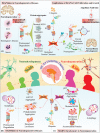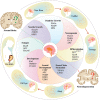E3 Ubiquitin Ligases Neurobiological Mechanisms: Development to Degeneration
- PMID: 28579943
- PMCID: PMC5437216
- DOI: 10.3389/fnmol.2017.00151
E3 Ubiquitin Ligases Neurobiological Mechanisms: Development to Degeneration
Abstract
Cells regularly synthesize new proteins to replace old or damaged proteins. Deposition of various aberrant proteins in specific brain regions leads to neurodegeneration and aging. The cellular protein quality control system develop various defense mechanisms against the accumulation of misfolded and aggregated proteins. The mechanisms underlying the selective recognition of specific crucial protein or misfolded proteins are majorly governed by quality control E3 ubiquitin ligases mediated through ubiquitin-proteasome system. Few known E3 ubiquitin ligases have shown prominent neurodevelopmental functions, but their interactions with different developmental proteins play critical roles in neurodevelopmental disorders. Several questions are yet to be understood properly. How E3 ubiquitin ligases determine the specificity and regulate degradation of a particular substrate involved in neuronal proliferation and differentiation is certainly the one, which needs detailed investigations. Another important question is how neurodevelopmental E3 ubiquitin ligases specifically differentiate between their versatile range of substrates and timing of their functional modulations during different phases of development. The premise of this article is to understand how few E3 ubiquitin ligases sense major molecular events, which are crucial for human brain development from its early embryonic stages to throughout adolescence period. A better understanding of these few E3 ubiquitin ligases and their interactions with other potential proteins will provide invaluable insight into disease mechanisms to approach toward therapeutic interventions.
Keywords: E3 ubiquitin ligases; aging; neurodegenerative diseases; neurodevelopmental disorders; neurons.
Figures



References
Publication types
LinkOut - more resources
Full Text Sources
Other Literature Sources

